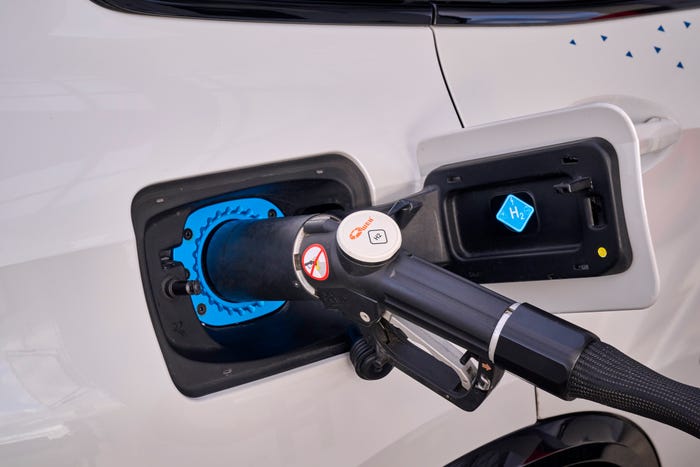Driving the Remarkably Unremarkable BMW iX5 Hydrogen Fuel Cell Vehicle
BMW makes its case for green hydrogen-fueled fuel cell vehicles targeting specific customer needs.

At a Glance
- 401 horsepower
- Sub-6.0 second 0-60 mph
- Quiet and smooth as a battery EV
Hydrogen fuel cells are pretty clearly the future for heavy over-the-road commercial trucks because of FCV’s advantages in weight, driving range, and refueling time, compared to battery electric vehicles.
Similarly, battery-electrics have the upper hand for regular, shorter-range jobs, which makes them advantages for most passenger car drivers, said Robert Halas, project manager for BMW’s iX5 Hydrogen FCV. Battery-electric vehicles have the advantages of greater efficiency and the ability for owners to charge inexpensively at home, he pointed out. “If you can charge at home, I would encourage you to do that,” he said.

BMW's hydrogen fuel cell-powered iX5 Hydrogen. BMW
Nevertheless, for a portion of the driving public who regularly make long drives, battery-electric vehicles are not a good solution. “The big advantage of the fuel cell car is the fast refueling,” he said. This is important for drivers who don’t have access to charging at home, who travel frequently, who live in a cold climate where battery efficiency is reduced, and those who regularly tow trailers.
Like the long-range truckers, these drivers are better served by hydrogen fuel cells, and BMW aims to provide them with what they need with the iX5 Hydrogen, a fuel cell version of the company’s iX5 BEV.
This vehicle employs a 125-kilowatt fuel cell stack that is paired with a battery that can deliver 170 kW, which combine to deliver power to the vehicle’s 295-kW (401 horsepower) electric motor. A total of 13.2 lbs. of compressed hydrogen packs into the iX5 Hydrogen’s dual carbon fiber storage cylinders in the vehicle’s floor.
All of this hardware creates a vehicle that weighs about the same as a plug-in hybrid vehicle and that weighs less than a battery electric, with its massive battery pack. Maximum driving range is 312 miles and refueling time is three to four minutes. The top speed is 115 mph and the iX5 accelerates to 60 mph in less than 6.0 seconds.

BMW iX5 Hydrogen fuel cell drivetrain. BMW
While today’s hydrogen supply comes mainly from natural gas, future supplies can be generated by surplus wind power, said BMW general program manager for hydrogen technology, Jürgen Guldner. Wind power is generated when the wind blows, not when there is demand for electric power, so much of that energy is wasted, he noted.
The solution is to use that surplus power to make hydrogen, providing fuel cell vehicles with fuel without using any otherwise useable power. “Last year Germany threw away 6 terawatt-hours of energy because nobody wanted it,” he said. Indeed, wind farms cannot be profitable ventures when so much power goes unused, Guldner asserted.
“Just selling wind energy as electricity is not enough to make the business case for wind power,” he said. “They need both electricity and hydrogen.” By 2030, infrastructure should be in place to harness that wasted power and create hydrogen, he said.

The iX5 Hydrogen's fuel cell stack fills the engine bay. BMW
Additionally, hydrogen provides a portable means of storing energy captured from solar cells in sunny areas and transporting that energy to less sunny areas, which makes solar panels a more attractive investment, Guldner added.
Fuel cell stacks decrease in power output over time, Halas acknowledged. But this degradation has been tested over more than 150,000 miles and found to remain within acceptable limits, Halas said. The vehicle’s hydrogen storage tanks have been tested for crash impact, in hot and cold weather, over long periods of time and driving distance, through many fueling cycles, and even in vehicle fire scenarios and have proved to be safe, according to Halas.
Behind the wheel, the iX5 feels like a battery EV, with the familiar feeling of silent electric torque providing brisk acceleration and thanks to the battery assist, no feeling of a lack of on-demand power from the fuel cell. “What is remarkable driving about the iX5 Hydrogen is how unremarkable it is,” said Halas, in a description that accurately reflects my time driving the vehicle.

The iX5 Hydrogen refills its tanks in less than four minutes. BMW
Other FCVs I’ve driven have produced a noticeable chugging sound from their compressors that is especially noticeable under load, as when accelerating. The BMW iX5, however, emits no such noise. As Halas said, it is unremarkably different from driving a battery EV. At least, until it is time to refuel in only a few minutes.
About the Author(s)
You May Also Like





